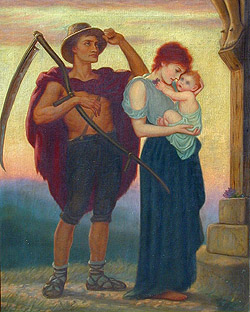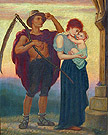| Title: |
Love and Labour |
| Artist: |
Prynne, Edward A. Fellowes (Plymouth, 1854 - Ealing, 1921) |
| Date: |
1904 |
| Medium: |
Original Oil Painting on Canvas |
| Note: |
Edward A. Fellowes Prynne 'Edward Fellowes Prynne': An important late nineteenth
and early twentieth century British painter, Edward Fellowes Prynne was
the third son of George Rundle Prynne, Reverend of St. Peter's, Plymouth.
He is known to have studied art in London, Antwerp, Florence and Paris.
Edward Fellowes Prynne established his home and studio in London shortly after 1880 and
began exhibiting there. During his career his paintings were shown at
such locations as the prestigious Royal Academy, London, and at major
galleries in Liverpool, Manchester and Glasgow. Edward Fellowes Prynne
was also a full member of the Royal Society of British Artists (R.B.A.),
and exhibited his art at their annual exhibitions. Today examples of his
paintings are included at the Church of St. Peter's, Plymouth, and at
the Russell-Cotes Art Gallery and Museum, Bournemouth. |
| |
During his career, Edward Fellowes Prynne excelled at portraits, figure
studies and allegorical scenes. Many of his works in this latter category
depict fairies and other supernatural forces. Fairy painting was a major
genre in Britain during the latter nineteenth century. Besides Prynne,
such well known artists as John Everett Millais, Richard Dadd, Noel Paton,
Daniel Maclise, Richard Doyle, Edward Burne-Jones and William Etty contributed
numerous works to this genre. One scholar writes,
"Fairy painting was close to the centre of the Victorian subconscious.
No other type of painting concentrates so many of the opposing elements
in the Victorian psyche: the desire to escape the drear hardships of
daily existence; the stirrings of new attitudes towards sex, stifled
by religious dogma; a passion for the unseen; psychological retreat
from scientific discoveries; the birth of psychoanalysis; the latent
revulsion against the exactitude of the new invention of photography.
It was the collision of these elements with the securely held beliefs
of former generations which resulted in paintings which are peopled
by creatures of the old mythology in fantastic settings, visualized
in the obsessive reality demanded by the newly propagated doctrine of
'Truth to Nature'." *
|
| |
Some of Prynne's best known paintings -- "A Sylph Distributing
the Early Morning Dew" and "O Ye Mountains and Hills" (1899) -- clearly
belong to this genre. Many of his other great works, however, combine
elements of the supernatural with a distinct 'Pre-Raphaelite' influence.
Such is the case with Love and Labour. Briefly, Pre-Raphaelite
painters (Millais, Hunt and Dante Gabriel Rossetti being the most famous)
strove to recapture the sincerity and simplicity of early Italian Renaissance
art, while completely rejecting the often trivial genre scenes which then
dominated contemporary British art. |
| |
Strong moral conviction is a key element to Pre-Raphaelite
art and is often relayed symbolically. In Love and Labour the man
clearly is representative of labour while the woman with her child symbolizes
love. Above them (to the upper right) is the Cross, to which the man fixes
his gaze. On this level the 'meaning' of the painting is self-evident;
God the Father stands over all. The women's eyes, however, are directed
downwards and the baby seems to gaze mysteriously at something beyond
our vision in space. |
| |
The wonderful portrayal of the mother and child, in fact,
in many ways stands in opposition to that of the husband and father. Labour
has made him strong and practical. His skin has darkened from many hours
of work in the sun. His feet are firmly planted on the earth. On the other
hand, the beautiful flesh and features of the mother are so compelling,
sensual and almost other-worldly that we find ourselves once again in
the supernatural genre of fairy painting. Furthermore, what so transfixes
the eyes of the baby that neither we nor the father can see it? What is
sure is that the mother and child are representative of an almost purely
spiritual world and that this magnificent work of art with its superb
colouration and modeling stands at the centre of Pre-Raphaelite painting. |
| Reference: |
* Jeremy Maas, Victorian Painters, New York, Harrison
House, 1978, p. 148. |
| |
E. Benezit, Dictionnaire des Peintres, Sculpteurs, Dessinateurs
et Graveurs, Paris, Librairie Grund, 1966, Vol. 4, p. 565 & Vol. 7,
p. 45. |
| |
Christopher Wood, The Dictionary of Victorian Painters,
Woodbridge, Suffolk, Antique Collector's Club, 1989, p. 382. |
| Size: |
36 X 28 1/2 (Sizes in inches are approximate,
height preceding width of plate-mark or image.) |
| |
Original English Antique Oak Frame |
| Buy Now |
Price: $7,500.00 US |
| Condition: |
Painted on stretched canvas and signed, titled and dated
on the verso by the artist. Faintly signed with the artist's monogramme
and dated within the painting to the lower right corner. This large and
magnificent painting is in excellent condition throughout without a trace
of fading or discolouration and represents a superb, original example
of the famous Victorian art of Edward A. Fellowes Prynne 'Edward Fellowes Prynne'. |
| Important Information: |
The artist biographies, research and or information pertaining to all the original works of art posted on our pages has been written and designed by Greg & Connie Peters exclusively for our site, (www.artoftheprint.com). Please visit us regularly to view the latest artworks offered for sale. We will soon be posting an update of our most recent research and include the biographical and historical information pertaining to our next collection of original works of art created by artists throughout the centuries. We hope you found the information you were looking for and that it has been beneficial.
Our Gallery, (Art of the Print / www.artoftheprint.com) guarantees the authenticity of every work of art we sell 100%. Full documentation and certification is provided. We offer a wide selection of international fine art dating from the early Renaissance to the contemporary art period. |




![]()
![]() or
phone Greg & Connie (905) 957-6666
or
phone Greg & Connie (905) 957-6666